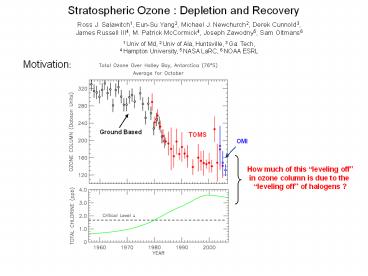Stratospheric Ozone : Depletion and Recovery - PowerPoint PPT Presentation
Title:
Stratospheric Ozone : Depletion and Recovery
Description:
James Russell III4, M. Patrick McCormick4, Joseph Zawodny5, Sam Oltmans6. 1 Univ of Md, 2 Univ of Ala, Huntsville, 3 ... SAGE II, HALOE, Sondes, Brewer/Dobson ... – PowerPoint PPT presentation
Number of Views:80
Avg rating:3.0/5.0
Title: Stratospheric Ozone : Depletion and Recovery
1
Stratospheric Ozone Depletion and Recovery
Ross J. Salawitch1, Eun-Su Yang2, Michael J.
Newchurch2, Derek Cunnold3, James Russell III4,
M. Patrick McCormick4, Joseph Zawodny5, Sam
Oltmans6 1 Univ of Md, 2 Univ of Ala,
Huntsville, 3 Ga. Tech, 4 Hampton University, 5
NASA LaRC, 6 NOAA ESRL
Motivation
Ground Based
TOMS
OMI
How much of this leveling off in ozone column
is due to the leveling off of halogens ?
2
Complication 1
Large year to year variability in temperature
3
Complication 2
Ozone reaches zero over considerable height
range. This saturation effect may be the cause
of the leveling off of the column ozone time
series
4
WMO 2006 (Chapter 6) Definition, First Stage of
Ozone Recovery
The occurrence of a statistically
significant reduction in the rate of decline of
ozone due to changing ozone depleting substances
5
Collar
Vortex
Equivalent Latitude
Equivalent Latitude
Data sources ? SAGE II, HALOE, Sondes,
Brewer/Dobson ? Classify data as vortex,
collar, or extra vortex using Equivalent
latitude at 440 K (Nash criteria PV from NCEP
reanalysis)
6
Total Ozone in Vortex Core, October
Ozone (DU)
Scatter plot, Detrended O3 vs Detrended
Temperature (70 hPa)
7
Scatter plot, Detrended Total O3 vs Detrended
Temperature (440 K)
Cold winters associated with larger vortices and
less ozone, due to combination of dyamical
effects and chemical effects related to
availability of PSCs (Boedeker et al., 2002
Newman et al., 2004)
8
Scatter plot, Detrended Total O3 vs Detrended
Temperature (440 K)
We use slopes of these curves, together with
yearly T residual, to derive Ozone Time Series
that account for yearly variations in
temperature and dynamics
9
Total Ozone October, Vortex Core
Early Warming
Record Cold
10
Total Ozone October, Vortex Core
Early Warming
Record Cold
WMO 2006 Polar EESC (Mean age 6 yrs Width 3
yrs Alpha 65 )
? Have dealt with Complication 1
(Meteorology) ? Now, must deal with Complication
2 (Loss Saturation)
11
Loss Saturation, Method 1 PDFs of Ozone
Difference Attributable to Loss Saturation
October vortex core mean ozone is 15 DU higher
(1997 to 2006) than predicted ozone
found using T residuals
and slope from 1979 to 1996 time period October
vortex collar 13 DU effect September core and
collar no discernable saturation effect
12
Ozonesondes
SAGE II
Loss Saturation, Method 2 ?(O3) vs
?(T)
October vortex core ozonesonde saturation
effect 8.9 DU (1.2 4.0 3.7)
SAGE II saturation effect
15.4 DU (4.1 5.4 5.9 )
13
Ozonesondes
SAGE II
Loss Saturation, Method 2 ?(O3) vs
?(T)
October vortex core ozonesonde saturation
effect 8.9 DU (1.2 4.0 3.7)
SAGE II saturation effect
15.4 DU (4.1 5.4 5.9 )
Adjust October core (collar) ozone time series by
mean values of 15 DU (13 DU) for 1997 to 2006,
with coldest years having larger adjustments
14
Total Ozone October, Vortex Core
Early Warming
Record Cold
WMO 2006 Polar EESC (Mean age 6 yrs Width 3
yrs Alpha 65 )
15
Deviation from 1979 to 1996 trend
Trend Analysis
16
Deviations are Statistically Significant (blue
dotted 95 confidence limit)
CUSUM Analysis
17
Conclude ? Antarctic Ozone, within both core
and collar region, is in the first stage of
recovery due to the leveling off of ozone
depleting substances ? In plain English
chemical loss is not getting any worse (use
of word recovery seems strange to me, but the
community has chosen this word to describe
this situation!) ? Yearly variations in
Antarctic ozone now driven by meteorology ?
Cold winters ? low ozone Next project
attribution of changes upper stratospheric ozone
using Aura/UARS MLS ClO, UARS HALOE CH4,
Aura MLS N2O, and UARS HALOE HCl and Aura
MLS HCl
18
Backup Material
19
(No Transcript)
20
(No Transcript)
21
Solomon et al., JGR, 2005































